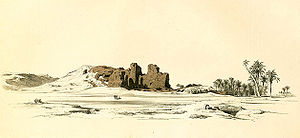Lepsius I pyramid
| Lepsius I pyramid | ||||||||||||||||||
|---|---|---|---|---|---|---|---|---|---|---|---|---|---|---|---|---|---|---|
|
Southeast view of the remains of the Lepsius I pyramid
(Karl Richard Lepsius, 1842)
|
||||||||||||||||||
The Lepsius I pyramid is the ruin of a large adobe monument in Abu Roasch near Cairo , which so far could not be clearly attributed to any ruler. It is located east of the Radjedef pyramid . The pyramid character of the structure is controversial.
exploration
The monument was first examined in 1837 by John S. Perring . He thought it was a very early pyramid and therefore believed to recognize the pyramid of Uenephes and the place Kochome in the ruins that are in the direction of Kirdasa . Manetho narrates that Uenephes , the fourth pharaoh of the 1st dynasty , built a pyramid in Kochome ( old Greek Κωχώμη).
In 1842 the pyramid was measured by Karl Richard Lepsius and cataloged as brick pyramid No. I in his list of pyramids . In a shaft he found an unlabeled, roughly hewn coffin, which Perring had already described. In its time the structure was 17 m high. But he reports that bricks for building houses or for fertilizing the fields were removed every day, so that today only the rock core is preserved. He estimated the original height to be around 145 m.
IES Edwards suggested, however, that the monument was the ruin of a large adobe mastaba . A detailed investigation was not carried out until 1985–1986 by Nabil M. Swelim , who identified the monument as the ruin of a large adobe pyramid. This study is so far the only one that has dealt with this pyramid in detail . The assignment as a pyramid has been controversial due to the low degree of preservation.
Dating and assignment
So far, the building could neither be dated exactly nor assigned to a specific pharaoh . No inscriptions or artifacts were found that could be used to identify the builder. Since it is unique in its properties among the Egyptian pyramids, it cannot easily be placed in a context .
Their immense size suggests a building of the 3rd or 4th Dynasty , while the adobe bricks were used as building material for pyramids in the 12th and 13th Dynasties .
Completion is unlikely, as is burial in the burial chamber, as over 30 rock tombs were carved into the rock core, which are dated to the 5th and 6th dynasties . This indicates that the pyramid was already a ruin abandoned as a burial site at that time.
Usually the structure is assigned to Huni (3rd Dynasty). Alternatively, Swelim suggests Neferka (4th Dynasty). Another, smaller adobe pyramid , the Pyramid of Athribis , is placed in a similar time frame.
construction
The pyramid was built from simple adobe bricks without straw as filler around a large rock core. The brick layers incline inwards at 75 ° -76 °, similar to the brick layers of the step pyramids of the 3rd dynasty. According to Swelim, the base length of the pyramid was 215 meters with a planned height of 107.5 to 150.5 meters. The Lepsius I pyramid was thus in the same order of magnitude as the Chephren pyramid . It has not been clarified whether the building should be completed as a step pyramid or whether it was planned with an external cladding as a real pyramid.
Substructure
The burial chamber with a square base area of 5.5 meters on sides and 5 meters in height is carved into the rock core. A 25 ° incline leads to the burial chamber from the north. There are no other chambers and galleries like those in the step pyramids of Djoser , Sechemchet and Chaba .
Literature / sources
- Nabil M. Swelim, Jamʻīyat al-Āthār bi-al-Iskandarīyah: The brick pyramid at Abu Rawash number 'I' by Lepsius: a preliminary study. Publications of the Archeological Society of Alexandria, Alexandria 1987.
Web links
- Francesco Raffaele: The Abu Roash Lepsius I Mudbrick Pyramid (engl.)
Individual evidence
- ^ A b Colonel Howard Vyse: Appendix to Operations carried on at the Pyramids of Gizeh in 1837. Fraser, London 1842, Vol. 3: Appendix .. , p. 9 ( excerpts on Google Books ).
- ↑ Karl Richard Lepsius: Monuments from Egypt and Ethiopia to the drawings of of His Majesty the King of Prussia Friedrich Wilhelm IV (1849). Reprint of the 1849 edition, Biblio, Osnabrück 1970, p. 21 f ( online ).
- ^ IES Edwards In: Kathryn A Bard, Steven Blake Shubert: Encyclopedia of the Archeology of Ancient Egypt. (EAAE) Routledge, London / New York 1999, ISBN 978-0415185899 , pp. 82-83.
- ↑ Miroslav Verner : The pyramids. Edition completely revised and expanded by the author. Rowohlt, Reinbek bei Hamburg 1998, ISBN 3-498-07062-2 , p. 177 f. The pyramid (?) Lepsius No. I.
Coordinates: 30 ° 2 ′ 27 ″ N , 31 ° 5 ′ 40 ″ E





